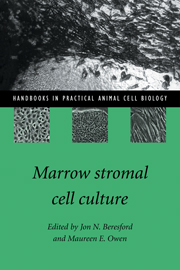Book contents
- Frontmatter
- Contents
- List of contributors
- Preface to the series
- Preface
- 1 The marrow stromal cell system
- 2 The bone marrow stroma in vivo: ontogeny, structure, cellular composition and changes in disease
- 3 Isolation, purification and in vitro manipulation of human bone marrow stromal precursor cells
- 4 Isolation and culture of human bone-derived cells
- 5 Marrow stromal adipocytes
- 6 Osteoblast lineage in experimental animals
- 7 Chondrocyte culture
- 8 Osteogenic potential of vascular pericytes
- Index
1 - The marrow stromal cell system
Published online by Cambridge University Press: 20 January 2010
- Frontmatter
- Contents
- List of contributors
- Preface to the series
- Preface
- 1 The marrow stromal cell system
- 2 The bone marrow stroma in vivo: ontogeny, structure, cellular composition and changes in disease
- 3 Isolation, purification and in vitro manipulation of human bone marrow stromal precursor cells
- 4 Isolation and culture of human bone-derived cells
- 5 Marrow stromal adipocytes
- 6 Osteoblast lineage in experimental animals
- 7 Chondrocyte culture
- 8 Osteogenic potential of vascular pericytes
- Index
Summary
Introduction
The stromal tissue of the bone marrow consists of a fine mesh of blood vessels held in a network of cells and extracellular matrix (ECM); it forms a continuum with the soft connective tissue adjacent to endosteal and periosteal bone surfaces and within Haversian canals. Marrow stromal tissue provides physical support and nourishment for the haemopoietic stem and progenitor cells and this led to the concept of a haemopoietic microenvironment (HME) (Dexter, Allen & Lajtha, 1977). In addition, the osteogenic potential of marrow stromal tissue has been well known for many decades (for review see Burwell, 1994).
The term ‘stromal cells’ has been used for the partially defined population of cells which make up the adherent cell layer in in vitro long-term bone marrow cultures (LTBMC) (Dexter, 1982). In this chapter, the term stromal is restricted to non-haemopoietic cells of mesenchymal origin and does not include macrophages and endothelial cells, which are also components of the adherent layer. There are three main cellular systems in the bone marrow; haemopoietic, endothelial and stromal, which are histogenetically distinct with no common precursor in the post-natal animal. The hypothesis of a marrow stromal cell system was based on analogy with the haemopoietic system (Owen, 1985); in essence, it is proposed that there are marrow stromal stem cells (MSSC) present within the bone marrow, able to generate the cell lines giving rise to the fibrous-osteogenic tissues of the skeleton and the stromal tissues of the HME (Friedenstein, 1980, 1990; Owen, 1988; Owen & Friedenstein, 1988).
- Type
- Chapter
- Information
- Marrow Stromal Cell Culture , pp. 1 - 9Publisher: Cambridge University PressPrint publication year: 1998
- 7
- Cited by



